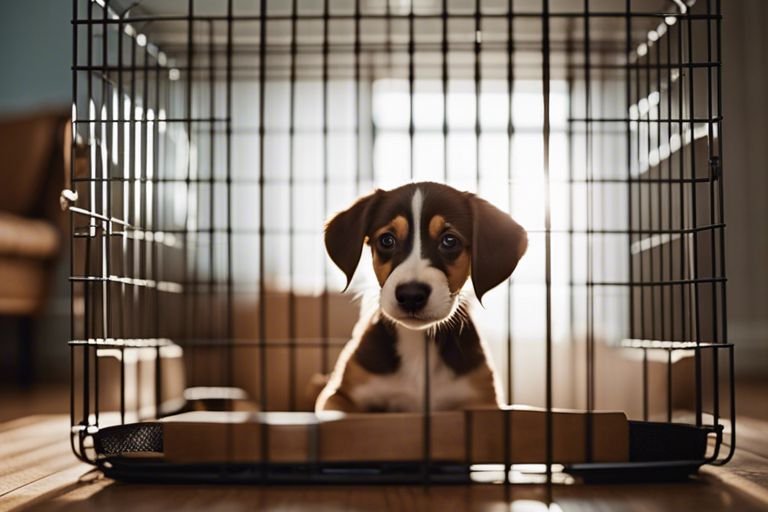Have You Considered Using Aversive Techniques In Puppy Crate Potty Training?

Just like any aspect of puppy training, crate potty training requires consistency, patience, and the right techniques to be successful. While positive reinforcement methods are widely recommended, some dog owners may consider aversive techniques as a quick solution. In this blog post, we will investigate into the use of aversive techniques in puppy crate potty training, their potential impact on your puppy, and alternative positive methods to help you make an informed decision for your furry friend’s training.
Key Takeaways:
- Aversive techniques in puppy crate potty training may have long-term negative effects: Using aversive techniques, such as scaring or intimidating a puppy to avoid accidents in the crate, can lead to behavioral issues, fear, and anxiety in the long run.
- Positive reinforcement is a more effective and humane approach: Rewarding a puppy for desired behavior, like pottying outside the crate, is a better method for encouraging good habits and building trust with your puppy.
- Consistency and patience are crucial in crate potty training: Establishing a routine, being patient with your puppy, and offering encouragement will yield better results in the long term compared to punitive measures.
- Seek professional guidance for effective crate potty training methods: Consulting with a professional dog trainer or behaviorist can help you develop a personalized and positive training plan for your puppy’s needs.
- Creating a safe and comfortable environment is necessary for successful crate training: Make sure your puppy’s crate is a cozy and inviting space with access to food, water, toys, and frequent bathroom breaks to promote potty training success.

Examining Aversive Training Techniques
Definition and Examples of Aversive Methods
Methods of aversive training involve using negative stimuli or consequences to discourage unwanted behaviors. Examples of aversive techniques include using a squirt bottle to spray water on a puppy when they have an accident in their crate, making a loud noise to startle the puppy when they exhibit undesirable behavior, or using a shake can filled with coins to create a loud sound that interrupts the behavior.
Pros and Cons of Aversive Training
| Can be effective in stopping unwanted behaviors quickly |
| May prevent harm to the puppy or others |
| Can provide clear communication of what is not acceptable |
| Can be used sparingly as a last resort |
| May create fear or anxiety in the puppy |
| Can damage the bond between the puppy and owner |
| Does not address the root cause of the behavior |
| Can lead to increased aggression or fear-based responses |
Effective Puppy Crate Potty Training Strategies
Establishing a Routine
Puppy crate potty training is most effective when a routine is established. This means feeding your puppy at the same times each day, taking them outside consistently, and putting them in their crate after each meal or playtime. Consistency is key in helping your puppy understand when and where they should go potty.
Positive Reinforcement Methods
Positive reinforcement methods are necessary in puppy crate potty training. This involves praising and rewarding your puppy when they go potty in the designated area outside the crate. Using treats, toys, or verbal praise can help reinforce good behavior and motivate your puppy to continue doing their business in the right place.
Plus, remember to be patient with your puppy. Crate potty training takes time and consistency, but with positive reinforcement and a solid routine, your puppy will eventually learn where they should go potty.

Addressing Common Challenges in Puppy Crate Potty Training
Dealing with Accidents
After bringing your puppy home, accidents in the crate can be a common and frustrating experience. However, it’s imperative to remain patient and consistent in your training approach. Accidents are often a sign that your puppy needs more frequent potty breaks. Make sure to take your puppy outside regularly, especially after meals, playtime, and naps. Clean up accidents thoroughly with an enzymatic cleaner to remove any lingering scent that may attract your puppy to eliminate in the same spot again.
Plus, remember to be patient with your puppy. Crate potty training takes time and consistency, but with positive reinforcement and a solid routine, your puppy will eventually learn where they should go potty.
Overcoming Resistance to Crate Training
For puppies that resist crate training, it’s important to introduce the crate gradually and make it a positive space. Start by placing treats and toys inside the crate to encourage your puppy to explore and enter voluntarily. Avoid using the crate as a punishment, as this can create negative associations. You can also feed your puppy meals near the crate and gradually move them inside to help your puppy feel more comfortable in the confined space.
Addressing resistance to crate training may take time, so be patient and consistent in your efforts. Gradually increase the amount of time your puppy spends in the crate, starting with short intervals and gradually extending them as your puppy becomes more comfortable. With patience and positive reinforcement, most puppies can learn to love their crates as a safe and comforting space.
Plus, remember to be patient with your puppy. Crate potty training takes time and consistency, but with positive reinforcement and a solid routine, your puppy will eventually learn where they should go potty.

Ethical Considerations and Alternatives
The Impact of Aversive Techniques on Puppy Well-being
Now, when considering using aversive techniques in puppy crate potty training, it is crucial to recognize the potential negative impact it can have on the well-being of your furry friend. Aversive methods can lead to fear, anxiety, and even aggression in puppies, which can have long-lasting effects on their mental and emotional state.
Non-Aversive Techniques for Successful Potty Training
Alternatives to aversive techniques for successful potty training involve positive reinforcement and patience. By using rewards and praise when your puppy goes potty in the correct place, you can encourage good behavior without the need for punishment.
For a more effective and humane approach to potty training, consider implementing a schedule for regular potty breaks, providing ample opportunities for your puppy to eliminate in the designated spot. Using crate training in a positive way, where the crate becomes a safe and comfortable space, can also aid in successful potty training without aversive techniques.
It is important to remember that puppies are learning and growing creatures who respond best to positive reinforcement and guidance. By using non-aversive techniques in puppy crate potty training, you can create a strong bond with your furry companion and set them up for success in the long run.
Summing up
So, when it comes to crate potty training for puppies, aversive techniques should be avoided. While they may yield short-term results, they can have negative long-term effects on your puppy’s well-being and the bond you share with them. Positive reinforcement, consistency, and patience are key elements in successful crate potty training. By using compassion and understanding, you can effectively train your puppy to eliminate in the right place without resorting to aversive methods.
FAQ
Q: What are aversive techniques in puppy crate potty training?
A: Aversive techniques in puppy crate potty training involve using negative stimuli or consequences to discourage unwanted behavior, such as soiling inside the crate. This can include methods like using loud noises, unpleasant smells, or physical corrections to deter the puppy from eliminating in the crate.
Q: Are aversive techniques effective in puppy crate potty training?
A: While aversive methodsmay yield immediate results in terms of stopping the unwanted behavior, they are not recommended for puppy crate potty training. These methods can have negative consequences on the puppy’s well-being and may lead to fear, anxiety, and distrust towards the owner.
Q: What are the risks of using aversive techniques in puppy crate potty training?
A: The use of aversive techniques in puppy crate potty training can lead to behavioral issues, such as increased anxiety in the puppy, a breakdown of trust between the puppy and the owner, and even aggression in some cases. It can also worsen the potty training process and make it more challenging in the long run.
Q: Are there alternative methods to aversive techniques for puppy crate potty training?
A: Yes, there are positive reinforcement techniques that are recommended for puppy crate potty training. These methods involve rewarding the puppy for desired behaviors, such as eliminating outside the crate, to encourage them to repeat those behaviors. Positive reinforcement helps build a strong bond between the puppy and the owner and leads to long-lasting results.
Q: How can I effectively potty train my puppy without using aversive techniques?
A: To effectively potty train your puppy without using aversive techniques, establish a consistent routine for feeding, watering, and bathroom breaks. Take your puppy outside frequently, especially after meals and naps, and reward them with treats and praise when they eliminate outside. Supervise your puppy closely while inside the crate and provide them with ample opportunities to relieve themselves outside the crate. Be patient, consistent, and positive throughout the potty training process to set your puppy up for success.




